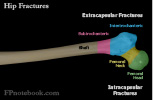Subtrochanteric Fracture, Subtrochanteric Femur Fracture
- See Also
- Epidemiology
- Uncommon Hip Fracture (accounts for only 3% of Hip Fractures)
- Pathophysiology
- Images
- Extracapsular Hip Fracture
- Contrast with Femoral Neck Fracture
- Mechanism of injury: Direct blunt Trauma
- High energy injury
- Gun shot wound
- Falls in the elderly
- Pathologic Fracture (Paget's Disease, Metastases)
- Diagnosis
- See Hip Fracture
- First 5 cm of femoral shaft below lesser trochanter
- Above Femoral Shaft Fracture
- Below Intertrochanteric Fracture
- Descriptive Classification
- Proximal or distal location
- Transverse or oblique angle
- Comminuted (common)
- Management
- See Hip Fracture
- Evaluate for associated injuries (see pitfalls below)
- Strongly consider regional Nerve Block (Fascia Iliaca Block or PENG Block) in hip and Femur Fractures
- Closely manage fluid status
- Initial Resuscitation with isotonic crystalloid
- Type and Cross for 2 Units pRBC
- Continually reassess hemodynamic status
- Intramedullary rod and nail (stabilizes femoral head and shaft)
- Perform in first 48 hours
- Pitfalls
- Significant blood loss
- From Hip Fracture or due to associated injuries
- Coexisting Fractures are common (up to 50%)
- High energy Trauma is associated with other injuries
- Complications
- Fat embolism
- Immobility associated morbidity
- Prognosis
- Mortality up to 20% due to comorbid injuries
- References
- Gurr in Marx (2002) Rosen's Emergency Med, p. 655-60
- Schroeder (2022) Am Fam Physician 106(6): 675-83 [PubMed]
- Sims (2002) Orthop Clin North Am 33(1):113-26 [PubMed]
